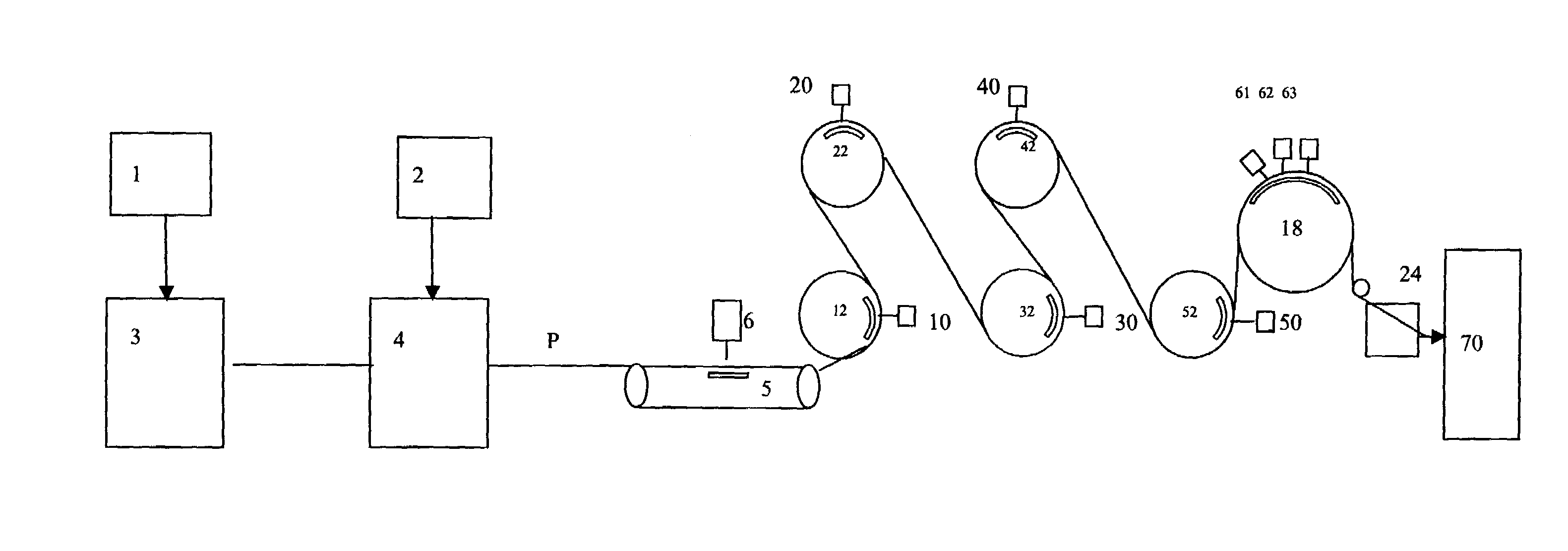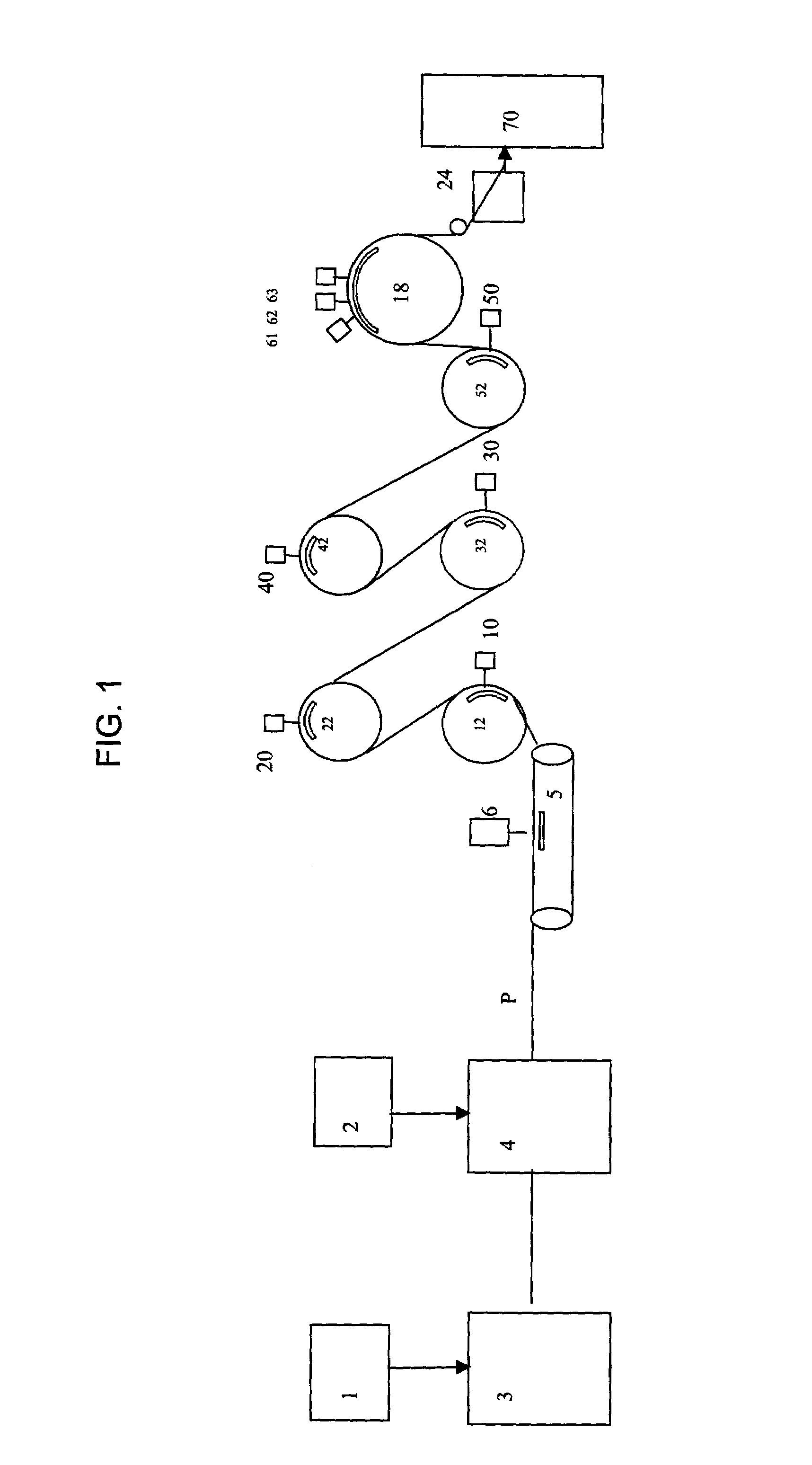Imaged nonwoven fabric comprising lyocell fibers
a non-woven fabric and lyocell technology, applied in the field of non-woven fabrics, can solve the problems of non-woven fabrics being disadvantaged when fabric properties are compared, non-woven fabrics are known to be complex, and the production of conventional textile fabrics is known to be a multi-step process, and achieve enhanced physical performance, drapeability, and durable
- Summary
- Abstract
- Description
- Claims
- Application Information
AI Technical Summary
Benefits of technology
Problems solved by technology
Method used
Image
Examples
example 1
[0032]A fabric was formed from two, cross-lapped (2 folds) drafted fibrous batts, each fibrous batt comprising: 52.5% by weight 0.99 denier by 1.5 inch T-472 PET fibers, as available from Wellman, 40% by weight 1.5 denier by 1.5 inch rayon Type 8191 as available from Lenzing, as available from Accordis, and 7.5% by weight 3.0 denier by 1.5 inch Type T-410 binder fiber, as available from Foss. The web was hydroentangled on a flat bed entangler 5 by manifold 6 operated at 40 bar. The precursor web was then positioned upon entangler 12 mounted with a foraminous support surface. The web was subjected to the action of water jets from one manifold 10 operated at 50 bar. The precursor web was then positioned upon an entangler 22 mounted with a foraminous support surface. The web was subjected to the action of water jets from manifold 20 operated at 90 bar. The precursor web was then positioned upon entangler 32 mounted with foraminous support surface. The web was subjected to the action of...
example 2
[0034]A fabric was formed in accordance with Example 1, wherein in the alternative, two cross-lapped (2 folds) drafted fibrous batts were used, each fibrous batt comprising: 52.5% by weight 0.99 denier by 1.5 inch T-472 PET fibers, as available from Wellman, 40% by weight 1.5 denier by 2.0 inch lyocell fiber H 205-913, as available from Accordis, and 7.5% by weight 3.0 denier by 1.5 inch CELLBOND Type 252 binder fiber, as available from Kosa.
example 3
[0035]A fabric was formed in accordance with Example 1, wherein in the alternative two cross-lapped (2 folds) drafted webs each comprising 62.5% by weight 0.99 denier by 1.5 inch T-472 PET fibers from Wellman, 30% by weight 1.5 denier by 2.0 inch lyocell fiber H 205-913 from Accordis and 7.5% by weight 3.0 denier by 1.5 inch CELLBOND type 252 binder fiber from Kosa.
[0036]The following test procedures have been established in connection with nonwoven fabrics.
[0037]
Basis WeightASTM D 377BulkASTM D 5729MD Tensile StrengthASTM D 5034CD Tensile StrengthASTM D 5034MD ElongationASTM D 5034CD ElongationASTM D 5034MD tearASTM D 5734CD teaASTM D 5734MD StiffnessINDA ST 90.0-75 R82CD StiffnessINDA ST 90.0-75 R82Air PermeabilityASTM D 737Mullen BurstASTM D 461 section 13MD Thermal ShrinkageSee BelowCD Thermal ShrinkageSee BelowMD Wash ShrinkageASTM D2724CD Wash ShrinkageASTM D2724
[0038]For thermal shrinkage the following procedure was used: Cut four samples across the full width of the fabric. ...
PUM
| Property | Measurement | Unit |
|---|---|---|
| weight | aaaaa | aaaaa |
| durable | aaaaa | aaaaa |
| diameter | aaaaa | aaaaa |
Abstract
Description
Claims
Application Information
 Login to View More
Login to View More - R&D
- Intellectual Property
- Life Sciences
- Materials
- Tech Scout
- Unparalleled Data Quality
- Higher Quality Content
- 60% Fewer Hallucinations
Browse by: Latest US Patents, China's latest patents, Technical Efficacy Thesaurus, Application Domain, Technology Topic, Popular Technical Reports.
© 2025 PatSnap. All rights reserved.Legal|Privacy policy|Modern Slavery Act Transparency Statement|Sitemap|About US| Contact US: help@patsnap.com


